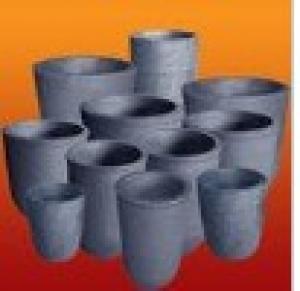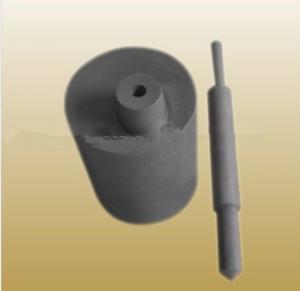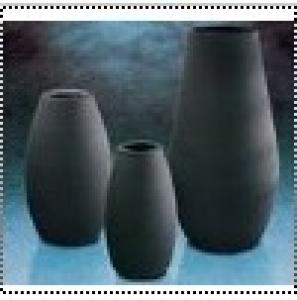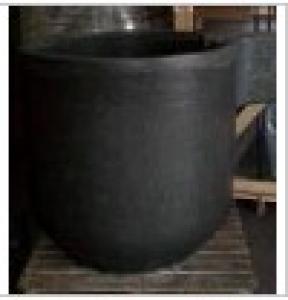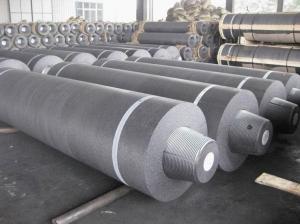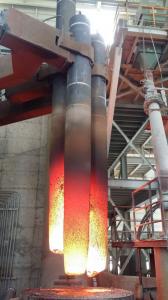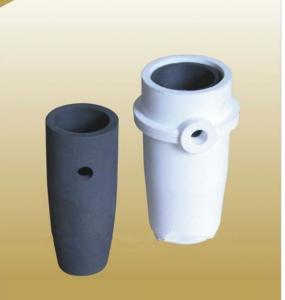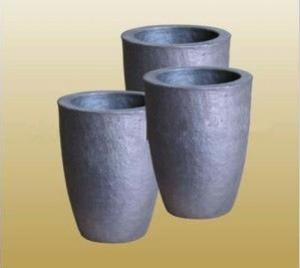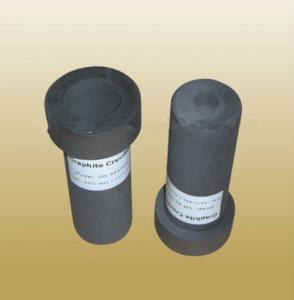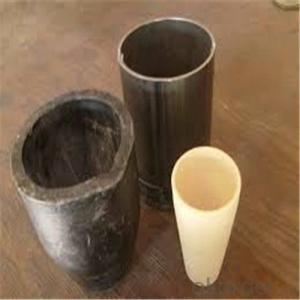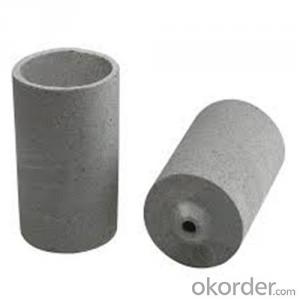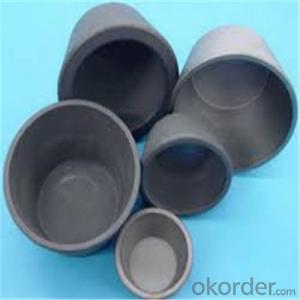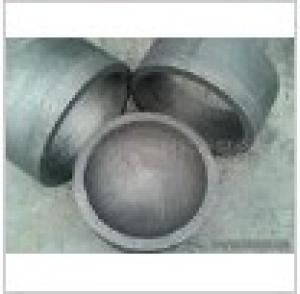Graphite Crucible Black
- Loading Port:
- China Main Port
- Payment Terms:
- TT or LC
- Min Order Qty:
- 1 Set pc
- Supply Capability:
- 5000 Sets per Month pc/month
OKorder Service Pledge
Quality Product, Order Online Tracking, Timely Delivery
OKorder Financial Service
Credit Rating, Credit Services, Credit Purchasing
You Might Also Like
Detailed Product Description
graphite crucible is featured by fast heat conduction,long service life and low cost and the product finds good application
1.Garphite crucible can withstand the high temperature, an has good resistance to chemical erosions and thermal shock.
2.Graphite crucible is ideal for the melting of gold,silver,aluminum,copper and other metals and is also used as a tool for smelting jewelry.
- Q:What material of graphite is used in arc furnace production?
- Today, large diameter semi graphitic carbon electrodes have been adopted in industrial silicon electric furnaces. Can effectively save production costs, and the technology is relatively mature.
- Q:How do you prevent oxidation of the graphite crucible during use?
- To prevent oxidation of the graphite crucible during use, there are several steps you can take: 1. Pre-condition the crucible: Before using the graphite crucible, it is important to pre-condition it by heating it gradually. This process helps remove any residual binders or impurities on the surface of the crucible, making it less prone to oxidation. 2. Apply a protective coating: Applying a protective coating to the graphite crucible can help prevent oxidation. There are various coatings available, such as boron nitride or zirconium oxide, which create a barrier between the crucible and the atmosphere, thus reducing the likelihood of oxidation. 3. Control the atmosphere: The atmosphere in which the crucible is used plays a crucial role in preventing oxidation. If possible, use a controlled atmosphere such as vacuum or inert gas (e.g., argon or nitrogen) during the heating process. This helps minimize the presence of oxygen, which can lead to oxidation. 4. Avoid rapid temperature changes: Rapid temperature changes can cause thermal shock, which can lead to cracks and increased susceptibility to oxidation. To prevent this, ensure a gradual and controlled heating and cooling process. 5. Clean the crucible after use: After each use, it is important to clean the graphite crucible to remove any residues or contaminants that may promote oxidation. Use a suitable cleaning agent and gently scrub the surface to ensure its cleanliness. By following these preventative measures, you can significantly reduce the oxidation of the graphite crucible during use, prolonging its lifespan and maintaining its effectiveness.
- Q:Can a graphite crucible be used for laser melting applications?
- Indeed, laser melting applications do allow the utilization of graphite crucibles. Renowned for their elevated melting point, exceptional thermal conductivity, and resistance to chemical reactions, graphite crucibles prove to be well-suited for high-temperature endeavors such as laser melting. They demonstrate resilience against the formidable heat produced by laser beams and effectively conduct heat to the material being melted, guaranteeing consistent and regulated melting. Furthermore, graphite crucibles are frequently favored for their robustness and long lifespan, rendering them a financially prudent option for laser melting applications.
- Q:How to judge the thermal stability of rubber oil?
- Thermal analysis method of qualitative thermal stability of 1 instrument 1.1 instrument differential thermal analyzer (DTA) and differential scanning calorimeter (DSC), temperature programmed rate at 2~30 C / min range, the precision of temperature control for soil 2 degrees, the size of power difference or temperature difference can reach 40% ~ 95% of the full scale deviation on the recorder.
- Q:Can a graphite crucible be used for melting food-grade substances?
- No, a graphite crucible should not be used for melting food-grade substances as graphite can react with the food and contaminate it. It is important to use food-grade materials specifically designed for heating and melting food substances.
- Q:How is a graphite crucible manufactured?
- A graphite crucible is typically manufactured using a process called isostatic pressing. Isostatic pressing involves placing graphite powder into a mold and subjecting it to high pressure from all directions. This process ensures that the graphite particles are evenly compacted, resulting in a dense and homogeneous crucible. The first step in manufacturing a graphite crucible is to select the appropriate graphite material. High-quality graphite with a low ash content is typically chosen for its excellent thermal conductivity, high temperature resistance, and chemical stability. The graphite is then milled into a fine powder to ensure a consistent particle size. Next, the graphite powder is poured into a flexible rubber mold. The rubber mold is designed to withstand the high pressure that will be applied during the isostatic pressing process. The mold is carefully sealed to prevent any leakage of graphite powder. The sealed mold is then placed into a high-pressure vessel. Hydraulic pressure is applied from all directions, exerting uniform pressure on the graphite powder. This pressure compacts the graphite particles, eliminating any voids or porosity that may be present. The high pressure also helps to align the graphite particles, resulting in improved mechanical properties. Once the pressing process is complete, the mold is removed, leaving behind a green crucible. The green crucible is then subjected to a baking process called carbonization. During carbonization, the crucible is heated to temperatures of around 3000 degrees Celsius in an inert atmosphere. This process removes any volatile materials and further strengthens the crucible. After carbonization, the crucible undergoes a final machining process to achieve the desired dimensions and smooth surface finish. This may involve precision grinding, turning, or milling to ensure the crucible meets the required specifications. In conclusion, a graphite crucible is manufactured through a process called isostatic pressing, which involves compacting graphite powder under high pressure. This process, along with subsequent carbonization and machining, ensures the crucible has excellent thermal conductivity, high temperature resistance, and chemical stability.
- Q:How does the wear resistance of graphite affect the performance of a crucible?
- The performance of a crucible is heavily dependent on the wear resistance of graphite. A crucible, which is used to hold and heat materials at high temperatures in industrial processes, often relies on graphite due to its unique properties, including high thermal conductivity, chemical inertness, and thermal stability. When it comes to a crucible, its ability to endure wear and erosion caused by intense heat and chemical reactions is a major factor. Graphite, known for its exceptional wear resistance, can withstand these harsh conditions, making it an ideal material for crucibles. By ensuring wear resistance, graphite helps maintain the structural integrity of the crucible, preventing degradation or breakdown during use. This is crucial in preventing contamination of the materials being processed or heated in the crucible. Contamination can negatively impact the final product's quality and purity, resulting in financial losses and compromised performance. Furthermore, graphite's wear resistance affects the lifespan of the crucible. A crucible with high wear resistance will last longer, reducing maintenance costs and improving efficiency in industrial processes. This allows for repeated use without frequent replacement, which can be both time-consuming and expensive. Moreover, graphite's wear resistance also influences the crucible's thermal stability. With its high melting point, graphite can withstand extreme temperatures without deforming or losing structural integrity. This ensures that the crucible maintains its shape, preventing cracks or warping under thermal stress. The ability to withstand high temperatures is vital for processes that involve prolonged heating or exposure to intense heat. In conclusion, the wear resistance of graphite significantly impacts the performance of a crucible. Its ability to endure wear and erosion helps maintain the crucible's structural integrity, prevents contamination, and extends its lifespan. Additionally, graphite's thermal stability allows the crucible to withstand high temperatures without deforming or breaking down. Overall, the wear resistance of graphite is a critical factor in determining the efficiency and reliability of a crucible in various industrial applications.
- Q:Can a graphite crucible be used for smelting or refining ores?
- Yes, a graphite crucible can be used for smelting or refining ores. Graphite crucibles are known for their high melting point, resistance to thermal shock, and excellent heat conductivity, making them suitable for high-temperature processes like smelting and refining.
- Q:What are the different methods of preventing cracks in a graphite crucible?
- There are several methods that can be employed to prevent cracks in a graphite crucible. 1. Preheating: Preheating the graphite crucible before use can help prevent cracks. This is done by gradually heating the crucible to the desired operating temperature, allowing the graphite to expand uniformly and reduce the likelihood of thermal shock. 2. Gradual cooling: After use, it is important to cool the crucible gradually. Sudden temperature changes can cause thermal stress and lead to cracks. Allowing the crucible to cool down slowly can help minimize this risk. 3. Avoiding rapid temperature changes: Graphite crucibles should be used in a controlled manner, avoiding sudden temperature changes. Rapid heating or cooling can cause thermal shock and lead to cracking. It is essential to maintain a consistent temperature during heating and cooling processes. 4. Proper handling: Handling the crucible carefully is crucial in preventing cracks. Avoid dropping or banging the crucible against hard surfaces, as this can cause physical damage and weaken the graphite structure. 5. Using protective coatings: Applying a protective coating to the inner surface of the crucible can provide an additional layer of insulation and prevent direct contact between the molten material and the graphite. This can help reduce chemical reactions and thermal stress, reducing the risk of cracks. 6. Regular maintenance and inspection: Regularly inspecting the crucible for any signs of wear, damage, or cracks is essential. Identifying any potential issues early on can help prevent further damage and ensure the crucible's longevity. By implementing these methods, one can minimize the risk of cracks in a graphite crucible and ensure its durability and effectiveness in various high-temperature applications.
- Q:Can graphite crucibles be used for thermal analysis?
- Yes, graphite crucibles can be used for thermal analysis. Graphite has excellent thermal conductivity and can withstand high temperatures, making it suitable for various thermal analysis techniques such as thermal gravimetric analysis (TGA) and differential scanning calorimetry (DSC). Its inert nature also allows for accurate measurement and analysis of thermal properties of the sample.
Our products are sold all over the country, and exported to America, Germany, Spain, India, Japan and Korea. Besides, we have strict management and advanced production technology.
We promise we will win more clients and a larger market with honest commercial credit, high quality of products, competitive price and good service.
1. Manufacturer Overview |
|
|---|---|
| Location | Inner Mongolia,China (Mainland) |
| Year Established | 2006 |
| Annual Output Value | US$2.5 Million - US$5 Million |
| Main Markets | 7.14% North America 7.14% South America 7.14% Eastern Europe 7.14% Southeast Asia 7.14% Africa 7.14% Oceania 7.14% Mid East 7.14% Eastern Asia 7.14% Western Europe 7.14% Central America 7.14% Northern Europe 7.14% Southern Europe 7.14% South Asia 7.14% Domestic Market |
| Company Certifications | |
2. Manufacturer Certificates |
|
|---|---|
| a) Certification Name | |
| Range | |
| Reference | |
| Validity Period | |
3. Manufacturer Capability |
|
|---|---|
| a)Trade Capacity | |
| Nearest Port | Xingang,Tianjin |
| Export Percentage | 31% - 40% |
| No.of Employees in Trade Department | 21-50 People |
| Language Spoken: | English, Chinese |
| b)Factory Information | |
| Factory Size: | 1,000-3,000 square meters |
| No. of Production Lines | 7 |
| Contract Manufacturing | 1,000-3,000 square meters |
| Product Price Range | Low and/or Average |
Send your message to us
Graphite Crucible Black
- Loading Port:
- China Main Port
- Payment Terms:
- TT or LC
- Min Order Qty:
- 1 Set pc
- Supply Capability:
- 5000 Sets per Month pc/month
OKorder Service Pledge
Quality Product, Order Online Tracking, Timely Delivery
OKorder Financial Service
Credit Rating, Credit Services, Credit Purchasing
Similar products
New products
Hot products
Related keywords
